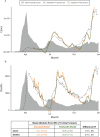Use of Telehealth Information for Early Detection: Insights From the COVID-19 Pandemic
- PMID: 38335480
- PMCID: PMC10862224
- DOI: 10.2105/AJPH.2023.307499
Use of Telehealth Information for Early Detection: Insights From the COVID-19 Pandemic
Abstract
Objectives. To examine whether the addition of telehealth data to existing surveillance infrastructure can improve forecasts of cases and mortality. Methods. In this observational study, we compared accuracy of 14-day forecasts using real-time data available to the National Syndromic Surveillance Program (standard forecasts) to forecasts that also included telehealth information (telehealth forecasts). The study was performed in a national telehealth service provider in 2020 serving 50 US states and the District of Columbia. Results. Among 10.5 million telemedicine encounters, 169 672 probable COVID-19 cases were diagnosed by 5050 clinicians, with a rate between 0.79 and 47.8 probable cases per 100 000 encounters per day (mean = 8.37; SD = 10.75). Publicly reported case counts ranged from 0.5 to 237 916 (mean: 53 913; SD = 47 466) and 0 to 2328 deaths (mean = 1035; SD = 550) per day. Telehealth-based forecasts improved 14-day case forecasting accuracy by 1.8 percentage points to 30.9% (P = .06) and mortality forecasting by 6.4 percentage points to 26.9% (P < .048). Conclusions. Modest improvements in forecasting can be gained from adding telehealth data to syndromic surveillance infrastructure. (Am J Public Health. 2024;114(2):218-225. https://doi.org/10.2105/AJPH.2023.307499).
Figures
Comment in
-
Harnessing Telehealth: Improving Epidemic Prediction and Response.Am J Public Health. 2024 Feb;114(2):146-148. doi: 10.2105/AJPH.2023.307547. Am J Public Health. 2024. PMID: 38335491 No abstract available.
References
-
- Centers for Disease Control and Prevention. Electronic Surveillance System for the Early Notification of Community-based Epidemics (ESSENCE) operations and maintenance support. Available at: https://sam.gov/opp/7951d04b4cc747bcad0a94dd92f83135/view?index=opp&naic.... Accessed November 22, 2021.
-
- COVID-19 ForecastHub. About the Hub. Available at : https://covid19forecasthub.org/doc . Accessed November 24, 2021. .
-
- Centers for Disease Control and Prevention. National Syndromic Surveillance Program. Overview . August 19, 2021. . Available at: https://www.cdc.gov/nssp/overview.html . Accessed October 24, 2021.
Publication types
MeSH terms
Grants and funding
LinkOut - more resources
Full Text Sources
Medical



